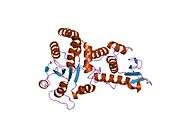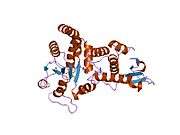CDC14B
Dual specificity protein phosphatase CDC14B is an enzyme that in humans is encoded by the CDC14B gene.[3][4]
The protein encoded by this gene is a member of the dual specificity protein tyrosine phosphatase family. This protein is highly similar to Saccharomyces cerevisiae Cdc14, a protein tyrosine phosphatase involved in the exit of cell mitosis and initiation of DNA replication, which suggests the role in cell cycle control. Specifically, it is thought to fulfil this role by bundling and stabilising microtubules. This protein has been shown to interact with and dephosphorylates tumor suppressor protein p53, and is thought to regulate the function of p53. Alternative splicing of this gene results in 3 transcript variants encoding distinct isoforms.[4]
Interactions
CDC14B has been shown to interact with p53.[5] However, this interaction has not been reported in other studies.
References
- ↑ "Human PubMed Reference:".
- ↑ "Mouse PubMed Reference:".
- ↑ Li L, Ernsting BR, Wishart MJ, Lohse DL, Dixon JE (December 1997). "A family of putative tumor suppressors is structurally and functionally conserved in humans and yeast". J Biol Chem. 272 (47): 29403–29406. PMID 9367992. doi:10.1074/jbc.272.47.29403.
- 1 2 "Entrez Gene: CDC14B CDC14 cell division cycle 14 homolog B (S. cerevisiae)".
- ↑ Li, L; Ljungman M; Dixon J E (January 2000). "The human Cdc14 phosphatases interact with and dephosphorylate the tumor suppressor protein p53". J. Biol. Chem. UNITED STATES. 275 (4): 2410–2414. ISSN 0021-9258. PMID 10644693. doi:10.1074/jbc.275.4.2410.
External links
- Human CDC14B genome location and CDC14B gene details page in the UCSC Genome Browser.
Further reading
- Maruyama K, Sugano S (1994). "Oligo-capping: a simple method to replace the cap structure of eukaryotic mRNAs with oligoribonucleotides". Gene. 138 (1–2): 171–174. PMID 8125298. doi:10.1016/0378-1119(94)90802-8.
- Suzuki Y, Yoshitomo-Nakagawa K, Maruyama K, et al. (1997). "Construction and characterization of a full length-enriched and a 5'-end-enriched cDNA library". Gene. 200 (1–2): 149–156. PMID 9373149. doi:10.1016/S0378-1119(97)00411-3.
- Li L, Ljungman M, Dixon JE (2000). "The human Cdc14 phosphatases interact with and dephosphorylate the tumor suppressor protein p53". J. Biol. Chem. 275 (4): 2410–2414. PMID 10644693. doi:10.1074/jbc.275.4.2410.
- Mailand N, Lukas C, Kaiser BK, et al. (2002). "Deregulated human Cdc14A phosphatase disrupts centrosome separation and chromosome segregation". Nat. Cell Biol. 4 (4): 318–322. PMID 11901424. doi:10.1038/ncb777.
- Kaiser BK, Zimmerman ZA, Charbonneau H, Jackson PK (2003). "Disruption of centrosome structure, chromosome segregation, and cytokinesis by misexpression of human Cdc14A phosphatase". Mol. Biol. Cell. 13 (7): 2289–2300. PMC 117313
 . PMID 12134069. doi:10.1091/mbc.01-11-0535.
. PMID 12134069. doi:10.1091/mbc.01-11-0535. - Strausberg RL, Feingold EA, Grouse LH, et al. (2003). "Generation and initial analysis of more than 15,000 full-length human and mouse cDNA sequences". Proc. Natl. Acad. Sci. U.S.A. 99 (26): 16899–16903. PMC 139241
 . PMID 12477932. doi:10.1073/pnas.242603899.
. PMID 12477932. doi:10.1073/pnas.242603899. - Dryden SC, Nahhas FA, Nowak JE, et al. (2003). "Role for human SIRT2 NAD-dependent deacetylase activity in control of mitotic exit in the cell cycle". Mol. Cell. Biol. 23 (9): 3173–3185. PMC 153197
 . PMID 12697818. doi:10.1128/MCB.23.9.3173-3185.2003.
. PMID 12697818. doi:10.1128/MCB.23.9.3173-3185.2003. - Gray CH, Good VM, Tonks NK, Barford D (2003). "The structure of the cell cycle protein Cdc14 reveals a proline-directed protein phosphatase". EMBO J. 22 (14): 3524–3535. PMC 165618
 . PMID 12853468. doi:10.1093/emboj/cdg348.
. PMID 12853468. doi:10.1093/emboj/cdg348. - Nalepa G, Harper JW (2005). "Visualization of a highly organized intranuclear network of filaments in living mammalian cells". Cell Motil. Cytoskeleton. 59 (2): 94–108. PMID 15362113. doi:10.1002/cm.20023.
- Cho HP, Liu Y, Gomez M, et al. (2005). "The dual-specificity phosphatase CDC14B bundles and stabilizes microtubules". Mol. Cell. Biol. 25 (11): 4541–4551. PMC 1140622
 . PMID 15899858. doi:10.1128/MCB.25.11.4541-4551.2005.
. PMID 15899858. doi:10.1128/MCB.25.11.4541-4551.2005. - Vázquez-Novelle MD, Esteban V, Bueno A, Sacristán MP (2005). "Functional homology among human and fission yeast Cdc14 phosphatases". J. Biol. Chem. 280 (32): 29144–29150. PMID 15911625. doi:10.1074/jbc.M413328200.
- Kimura K, Wakamatsu A, Suzuki Y, et al. (2006). "Diversification of transcriptional modulation: large-scale identification and characterization of putative alternative promoters of human genes". Genome Res. 16 (1): 55–65. PMC 1356129
 . PMID 16344560. doi:10.1101/gr.4039406.
. PMID 16344560. doi:10.1101/gr.4039406.



